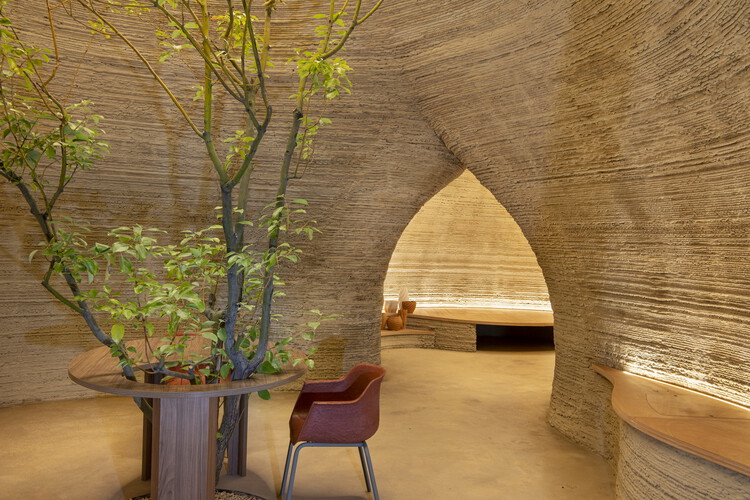Can you imagine a world in which the built environment around us is 3D printed from living materials? That buildings will germinate, bloom, wither, produce new kinds of material, and eventually return back to the soil? To Grow a Building is a performative lab space that 3D prints – in real time – a live structure. The project presents a new approach to integrating flora into the design process, by developing a novel material for 3D printing, through which seeding is an inseparable part of the fabrication process. To Grow a Building is a gate into a future world in which there are people who build buildings, and there are people who grow them.
At Jerusalem Design Week 2022, designers Elisheva Gillis, Gitit Linker, Danny Freedman, Noa Zermati, Adi Segal, Rebeca Partook, Or Naim, and Nof Nathansohn imagined the possibility of a world in which buildings are 3D printed from organic materials. In this outdoor performative lab space presented on the grounds of Hansen House and supported by Rogovin, a company that promotes ecological innovation in the field of real estate, a custom-made robotic arm built small structures using a mix of soil and seeds.
Linked to the robot’s computer, each structural design was built by the robotic arm in a systematic, almost mesmerizing, manner. Upon completion, structures adopt a life of their own: the seeds sprout, covering the soil with lush vegetation, and roots take hold within.
Instead of buildings made of concrete and steel, the project suggests an architecture that uses local soil and roots as structural elements. As the world faces an ecological crisis, the use of industrial and non-local resources is only increasing.
The eleventh edition of Jerusalem Design Week welcomed more than 40,000 eager visitors to the Hansen House Center for Design, Media, and Technology. Israel’s leading design event, Jerusalem Design Week showcased an eclectic mix of exhibitions, installations, and projects, from over 150 Israeli and international designers. Created especially for this year’s theme ‘For Now’, work by invited designers explored both the ephemerality of design and the design of ephemerality. JDW examined how time can be harnessed to bring about a positive effect in periods of uncertainty.
Though showcased during JDW this year, the notion of 3D printing from living materials has been explored through other projects as well. Located in Massa Lombarda (Ravenna, Italy), Mario Cucinella Architects and Wasp, Italy’s leading 3D printing company, had previously completed the first house to be 3D printed from raw earth using a process called TECLA (technology and clay).
TECLA is an innovative circular housing model that brings together research on vernacular construction practices, the study of bioclimatic principles, and the use of natural and local materials. It is a nearly zero-emission project: its casing and the use of an entirely local material allow for the reduction of waste and scraps. This and the use of raw earth make TECLA a pioneering example of low-carbon housing.
As well as combining the use of soil, seeds, and raw earth alongside 3D printing technology, the possibility of using mycelium in the construction process has also been heavily considered and explored in recent years as a potential building material. Mycelium is a natural fungi material that is organic, compostable, and biodegradable, with industrial-level strength that could be used as the building blocks for future homes.
The Living has explored the use of mycelium in the building process through their winning design at the 2014 MoMA PS1 Young Architects Program, Hy-Fi. The project was the first large structure to be made of this new material, with these organic bricks harnessing the incredible ‘biological algorithm’ of mushroom roots, tuning it to manufacture a new building material that grows in five days, with no waste, no input of energy, and no carbon emissions.
Imagining a future where the architecture that surrounds us will be completely constructed from eco-materials doesn’t seem so far off in the light of the technological advancements we have witnessed within the past decade. More and more are we coming to encounter architecture around us that lives and breathes, just as we do, growing, evolving, and changing to fit the mold of what the future of the architectural scene needs: sustainability and innovation, and what better way to start than with the building blocks of the built environment.























![Green Building Materials Market Trends [2023-2030]](https://housingcable.ng/wp-content/uploads/2022/04/csrgreen-building_Cisco_04222022-218x150.png)








